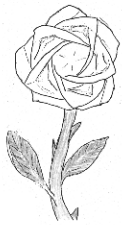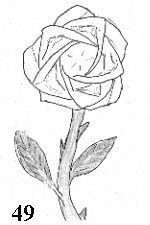Credits
"Marie's Rose" was designed by
Marie Tessier.
It is a 5-sided variation on Toshikazu Kawasaki's 4-sided "Rose".
To Jasper's knowledge (as of August 2000),
"Marie's Rose" is the second true rose (with full 5-fold symmetry).
The first was the "White Rose", by Elsa Chen and Jasper.
Kawasaki's "Rose" is diagrammed on pages 128-130 of
Origami for the Connoisseur, by Kasahara and Takahama.
Chen's original (4-sided) "Rose Bowl" was created in 1997,
and diagrammed in the June 1999 issue of the
West Coast Origami Guild (WCOG) Newsletter.
The "White Rose" was diagrammed in the October 1999 issue
of the WCOG Newsletter.
|















